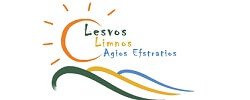The coastal wetlands of the Gulf of Kalloni are one of the most important ecological assets of Lesvos. The coastal areas around the Gulf of Kalloni are a cohesive ecosystem, as in that region there are many saltmarshes, estuaries of small rivers and streams, reed beds, a pine forest and olive groves included in the National & European List of Special Areas of Conservation of NATURA 2000. The formed wetlands are used as shelter and place of reproduction by 252 bird species of which 87 are protected species. Here you will meet shelducks, stilts, glossy ibises, kingfishers, redshanks, avocets, pink flamingoes, black storks, swans etc. In the broader region there is a great variety of rare flora species, such as orchids, and spontaneous vegetation, which together with the salt pans sites offer abundant food and natural shelter to all organisms while also contributing to the preservation of biodiversity on Lesvos
The wetlands of the marshes of Ntipi-Larsos with the river of Evergetoulas, are of great ecological value. The surface of the marsh is covered almost entirely by a dense reed bed, the largest in the Aegean. The wetland offers shelter to a great number of plants, serpents, amphibians, birds, insects and to the rarely seen Eurasian otter (Lutra lutra). Some of those species are protected. The waters of tributaries create sites of natural beauty and also this area is included in the Special Areas of Conservation of the NATURA 2000 Network.
At the southeast part of the Gulf of Kalloni, you will find the wetland of Polichnitos. It is a saltmarsh at Skala of Polichnitos. More than 100 bird species have been recorded in that region. For biologists and nature observers it is a living example of natural history. Observation is possible throughout the year, but especially in spring where there is a great arrival of birds. However, also the terrestrial biotopes of Polichnitos are important part of that region. Serpents, amphibians and mainly mammals find shelter there, among them the most beautiful mammal of the island, the Caucasian squirrel (Sciurus anomalus).
In the region of Vatera at the estuary of the rivers Almiropotamos and Vourkos, you will find an interesting wetland with great avifauna and a variety of animal species. At the region of Vatera you will also find the sea daffodil (Pancratium maritimum), a rare and very beautiful white flower growing in the sand during September, as well as the sea lavender (Limonium sinuatum), which colours the beach with this wonderful blue-purple flowers.
In spring, the dispersed small wetlands of western Lesvos, attract migratory shore and aquatic birds. This time of the year, every small water surface can offer food and rest to the exhausted feathered visitors. the variety of the terrestrial biotopes that can cover, even temporarily, the ecological demands of the migratory species is equally important. Most natural wetlands of the region such as in Lapsarna, Faneromeni, Faros Limena, Tsixliotas river, Chroussos estuary, Elafi, the artificial lake in the Monastery of Pythari, Voulgaris-Omvriokastro estuary, Skala of Eressos, are very small in size but altogether constitute a network of important feed and rest spots for birds. That’s why their protection is important.
In the last years the activity of bird-watching has been developed on the island, as the areas mainly of wetlands attract the interest of many visitors, scientists and nature lovers who arrive mainly in spring and autumn to admire the flora and avifauna of the island.


 Greek
Greek







